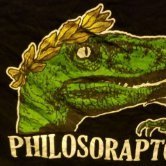All Activity
- Today
-

songs remembered from just one line
WordWolf replied to bulwinkl's topic in Movies, Music, Books, Art
"Welcome back my friends to the show that never ends. We're so glad you could attend, come inside, come inside. There behind the glass stands a real blade of grass, be careful as you pass, move along, move along." -
Another teen visited Riverdale. A famous one with her own series'. Airing before and after Riverdale. Her aunts were in one of her series, but I doubt they visited Riverdale. Perhaps the right question is not "who", nor "what". We're not looking for the Shield, the Web, the Jaguar, the Fly or Fly Girl, Black Jack, nor Steel Sterling.
-
Of course he's correct. It contains all the original dialogue, but with a modern setting. The opening narration is delivered on an evening newscast, with modern images. "Two houses, both alike in dignity, in fair Verona, where we lay our scene..." We see two conglomerates, rival companies, Montague and Capulet, both based in Verona Beach, California. John Leguizamo was cast as the hot-blooded Tybalt, Juliet's cousin and starter of fights. All the lines are understood due to visuals. As the young turks draw their pistols on each other, the camera zooms in to the side of one pistol- "SWORD 9 MM". Then the line "Put up your swords!" has an obvious meaning. In the riot early in the story, Old Montague (Dennehy) is in an armored limo, with a rifle holstered to the roof. "Hand me my Long Sword." The news handles the opening and closing of the story, as does the narration. High school students should have no trouble understanding the scenes, even if the Elizabethan dialogue gives them trouble. The brand names explain terms and expressions- pistols by "Sword", the FedEx-like mailing service called "Post-Haste" for "I shall send it Post-Haste", and so on. The original play is defined as a tragedy. I would like to see some other Shakespearean plays get a similar treatment. David Tennant's run of Hamlet with the RSC resembled that, with Hamlet in a castle that included security cameras. (I hear the Hawke version was moreso.) But there's lots of other plays waiting for modern audiences who would appreciate them re-visualized in modern settings. So, it's WordHusky's turn.
-
Thank you for using these "" with accuracy and precision.
-
Obviously the newer version. I've only seen the 1968 film. But a quick IMDb search shows that WordHusky is correct. George
- Yesterday
-
WordHusky started following Movie Mash-Up
-
That's definitely Romeo + Juliet. Original by William Shakespeare. Also, hi, I'm still here.
-
Well, not incorrect. She was the only other Archie character I can think of. YMMV. Obviously, there were Betty and Veronica. Both were in cartoons and live action (Riverdale) but meet none of your other qualities. I'm pretty sure Midge, Big Ethel, and Miss Grundy are out, too. Archie Comics also had some super-heroes (The Jaguar, The Fly, and another (Black Hand?)) but no females. I'm stumped. George
-
Alas, it was only after having been tricked by Victor Wierwille's "ministry" for more than a dozen years did I learn to recognize this very salient point.
-
"We ruled out Josie McCoy." Correct. "The only other Archie character I can think of with her own show was Katy Keene, but she certainly didn't have more shows than Supergirl." INcorrect. Think some more. You missed somebody famous. "Indies like Dark Horse weren't around in the 60s." We agree. "Was this a Gold Key character?" This was not. BTW, this character appeared, for a short time, on a cartoon around 1970 that had NOTHING to do with the Archies, and was the only established character who would have been apt to do so. Despite being in a different setting of cartoon, it borrowed from Laugh-In and the Archies- it had the wall with the one-off jokes, and a musical number every episode. Out of all her early appearances, that was the only cartoon I watched. And I had to get up really early Saturday mornings to see it. Her live-action shows are a lot more famous, and at least one may be in syndication right now (I suspect 2 are watchable on demand if you know where to look and live in the US.
-
I should say that Brent Niedergall’s work on the idiom ἐντεῦθεν καὶ ἐντεῦθεν was not a direct response to Bullinger. He was responding to a simple question by an antagonist in denial: why doesn’t the expression distribute the two crucified, two here and two there? So, Brent doesn’t seem to have an agenda to advance. He is simply taking an honest academic approach to the text and grammar. He answered the question sufficiently. The explanation of the grammar is so clear that I wonder if Bullinger shouldn’t have known better, and if he didn’t, how much salt should be taken with anything he wrote? Further down the thread on this message board, someone mentioned that when an interloper is continuously dissatisfied with satisfactory answers, an agenda is often involved. Then a link to Bullinger’s appendix was posted.
-
Look out, Cuba! George
-
We ruled out Josie McCoy. The only other Archie character I can think of with her own show was Katy Keene, but she certainly didn't have more shows than Supergirl. Indies like Dark Horse weren't around in the 60s. Was this a Gold Key character? George
-
Although it is true that "absence of evidence is not evidence of absence" (just because we haven't found evidence doesn't mean there is none,) but that is falsely taken to mean that one can just SUPPOSE there's evidence SOMEWHERE even if no evidence is found. vpw did that a number of times. He took a position, and SUPPOSED that SOMEWHERE, there was text to support the position. Nothing works that way. You find the evidence, and study the evidence, and THEN you form the position based on the evidence at hand. Until there's evidence of something, it's premature to say it is so. All textual evidence so far says TWO others crucified, total. The verses in John, at most, could be taken either way- and, as we just saw, seem to support two others crucified, total. NOTHING so far says FOUR others total. To insert an idea where the evidence does not go is not sound research, is not sound work, is not sound reasoning. It places one firmly in the camp of "conspiracy theorists." I'm open to discussing another text- if one ever appears. Until then, the "four crucified" have not presented a CREDIBLE case. "Bullinger said so". Yes, and Bullinger is human and can make stuff up just like anyone else. He presented nothing substantial, only suppositions.
-
................... Keep going.........
-
If it's a DC character, I'm not seeing it. If it's a Marvel character, I won't get it. George
-
Since neither John 19:18 nor any early text says ἐσταύρωσαν... μετ᾿ αὐτοῦ ἄλλους τέσσαρας, δύο ἐντεῦθεν καὶ δύο ἐντεῦθεν (“they crucified... four others with him, two here and two there”), Bullinger's fantastic imagination has not met the standards of proof required to establish it. (Not even the second time.) Why do you think it is that not a single gospel or any other text in the history of early Christendom says that there were four crucified with him? Is there a conspiracy to obscure how many people were crucified alongside Jesus? Every single gospel says two (Matt 27.38; Mark 15.27; Luke 23.32; John 19.18). Not a single one says four. And the earliest Church Fathers, Ignatious, Justin Martyr and Irenaeus, all write of two crucified. This is the major problem that no amount of mistranslating and text twisting can resolve. Of course, I'm open to textual evidence proving four crucified, as I am open 19 crucified, or 79, or 427 or...
-
Yes! Both, actually.
-
The "seed drill" comment was directed at Human. Sigh. Looks like some people can't be trained. BTW, if "crazy mover" itself doesn't have a meaning, maybe it's because it's the wrong phrase.
- Last week
-
"Crazy mover" must have some meaning, but I'm not getting it. Not "seed drill" either. George
-
By "more shows," do you mean more series or more episodes? George
-
Hey, Human! I've got this new invention. I call it "the seed drill." Think you can help me file the patent?
-
No. Review your lines of reasoning again. You had all the legwork already worked out. Not counting CoIE, this is someone who has appeared in more shows than Supergirl, and certainly has had more of her own shows than Supergirl! However, she has had fewer theatrical releases. (AFAIK.)
-
No, AFAIK. This is not something for which you can train, you crazy mover. Think it over and try again.
-
Previously, we discussed how translations work. We discussed how word-for-word translations can and WILL be misleading and confusing. Sometimes, words must be supplied by the translator so the idiom expressed in the source language is understandable in the target language. This is not a dishonest corruption of text, it is simply sound translation methodology. The following is an excellent treatment of the idiomatic expression in question, ἐντεῦθεν καὶ ἐντεῦθεν. I happened upon this in an academic Biblical Greek message board a few years ago. The thread was originated by a random user seeking to confirm his bias, seeking evidence AFTER asserting his conclusion. This was one of the answers from Brent Niedergall. https://niedergall.com/an-obscure-greek-question-no-longer-waiting-for-an-answer/ "Internet message boards and social networks normally serve as bustling forums where people can ask questions and expect rapid answers. Recently, however, I came across one question that had been languishing in the data dunes for years. Someone was re-asking a question from eight years before that they felt never got its day in court. It centers on John’s account of the crucifixion, specifically his use of an idiom—an expression. It’s one I’ve never considered, and one, to my knowledge, that has received little attention in the literature. Let me show you. In John 19, Jesus is taken to Golgotha for crucifixion. In v. 18 we read: So the idiom in question is this “ἐντεῦθεν καὶ ἐντεῦθεν.” The word ἐντεῦθεν by itself has the sense of “from here.” The idiom, therefore, would have the sense of “from here and from there.” Some wonder what justification the translators had for translating this as “one on either side.” Why couldn’t we instead understand this verse to mean that there were two others on either side of Jesus—five men on five crosses with Jesus in the center? Is it possible? Well, from the outset, if we keep reading John 19, we see that the question is a non-issue. When we get to v. 32, we’re explicitly told the soldiers broke the legs of the two others crucified with Jesus. There were only three men on crosses. But let’s dig into this idiom further. The Grammar Ἐντεῦθεν is an adverb, a word that modifies either a verb, an adjective, or another adverb. An adverb answers questions like: “Where?”, “When?” or “In what way?” The adverb ἐντεῦθεν answers the question “Where?” This makes perfect sense because according to BDF, adverbs ending in -θεν (e.g., πόθεν, ὅθεν, ἔνθεν, etc.) answer the question ‘Whence?’ So if adverbs modify, what is ἐντεῦθεν modifying? Here it modifies the elided verb ἐσταύρωσαν (“they crucified”) describing the action of the Roman soldiers crucifying these two other men with Jesus. John chose not to repeat the verb because it’s understood from the previous clause. Therefore, these two others have been crucified on either side of Jesus. Now let’s look more at this expression. Examples to Consider You actually won’t find this exact construction anywhere else in the New Testament or Septuagint. A much more common idiom that uses a synonymous term is ἔνθεν καὶ ἔνθεν, which occurs over thirty times in the Septuagint. This idiom will also be considered under Example #3 because it can be equated with ἐντεῦθεν καὶ ἐντεῦθεν. Now, here are three examples from the Septuagint. Example #1: Exodus 17:12 In this example, the number one (εἷς) is separately assigned to both sides. Example #2: Joshua 8:22 In this example, the demonstrative pronoun οὗτος has been separately assigned to both sides. This is similar to what we saw in Example #1 with the number one. Example #3: Ezekiel 40:10 Out of over thirty occurrences of ἔνθεν καὶ ἔνθεν in the Septuagint, only a few have anything to do with cardinal numbers (Ezek 40:10, 41, 48, 49; 41:2), and each of these functions the same way: it states the number with both the first and second occurrence of ἔνθεν. Here’s Ezek 40:10 as a third example. Again, you can see how number is given to clarify that there were three rooms on each side. Drawing Conclusions In the first two examples, the number is stated to show that this was how many are on each side separately. Whenever the author wants to make it clear that he is describing two separate entities that should be understood as such, he does so. In Exodus, Aaron was the one at one side of Moses, and Hur was the one on the other. In Ezekiel, there are three rooms on one side and three on the other. This is not the case in John 19:18. If John wanted to say there were two on each side, he would have included a second δύο to read ἄλλους δύο ἐντεῦθεν καὶ δύο ἐντεῦθεν. Among the New Testament and LXX, there is no evidence to be found where a single number serves to indicate that this number was on one side and on the other side. At long last, there is an answer for an eight-year-old question. Even if the question didn’t necessarily need to be answered, I think that doing so helped to shed some additional light on a few words of Scripture. Note: English translations of the New Testament are taken from the English Standard Version (ESV) unless otherwise stated. English translations of the Septuagint come from the Lexham English Septuagint (LES). *An asterisk indicates my own translation."
-
Like so many other "lessons" propounded by TWI, 4 crucified was meaningless drivel. If one hasn't learned to treat their fellow man with the respect and equity with which they, themselves, would yearn to be treated, they have leaned nothing at all. You can learn to ride a bike, put it away for 50 years, and climb right back on after all that time, still possessing the ability to ride a bike. Not so with interpersonal relationships. There is no end point. Every day is another chance to do better than you did the day before. This concept of becoming a better human being is lost to TWI's endless pursuit of pedantic excellence.


